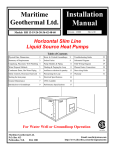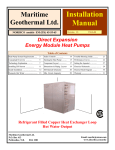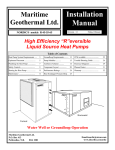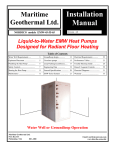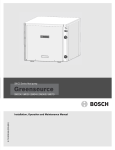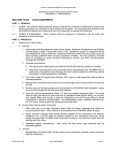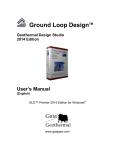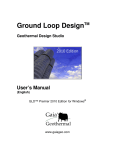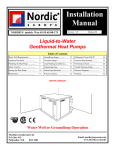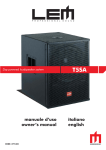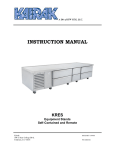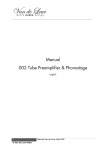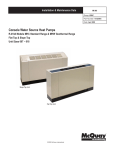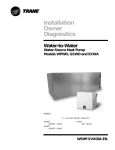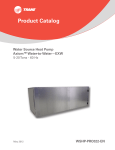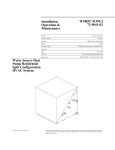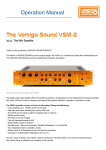Download Installation Manual
Transcript
Maritime Geothermal Ltd. Installation Manual NORDIC® models DXW-45-55-65 Revision 1.1 June, 1997 DX-to-Water Direct Expansion Heat Pumps Table of Contents Heat Pump System Requirements ..... 3 Dimensions & Piping Layout 18 Method of Operation ………. 30 Installation Instructions ………. 7 Trouble Shooting Guide .......... 22 Warranty ............................... Installing DX linesets .................. 9 Component Layout ................ 21 Inside Installation …………………. 12 Electrical Schematic ............. 25 Starting the Heat Pump …………... 13 Electrical Block Diagram .......... 24 Theory of Operation............................ 15 DX Micro controller …….. 27 25 Refrigerant Filled Copper Heat Exchanger Loop Hot Water Output Maritime Geothermal Ltd. P.O. Box 413 Petitcodiac, N.B. E0A 2H0 Email: [email protected] www.discribe.ca/nordic/mgmain.htm 12-Feb-00 Maritime Geothermal Ltd. A NORDIC® Direct Expansion Heat Pump System Energy Input: Solar Geothermal Storage System: Earth’s Mass HEATING Extraction & Rejection System: “DX” heat pump Heat Distribution: Ductwork and/or Infloor Heating NORDIC® DX-to-Water NORDIC® DX-to-Air Page .... 2 COOLING Maritime Geothermal Ltd. 12-Feb-00 NORDIC® DXW Heat Pump System Prerequisites 1. 2. 3. 4. There are four specific parts or sub-systems to a DXW heat pump installation: The source of energy ............................................................... Solar & Geothermal The storage media ................................................................... The Earth’s mass Converting the energy to a useable form ................................... Heat Pump Distributing the heat ..................................................................Hot Water / radiant slab Horizontal Loop Fields The successful application of a DXW heat pump depends on sizing the machine correctly for the home or area to condition and providing enough land area or volume of earth from which to extract or reject heat. DXW heat pumps react with the earth much like a conventional reversing heat pump and closed loop plastic earth heat exchanger. Heat that is available to the unit must travel through the earth and therefore the conduction capability of the earth in the location of the Model # of Loops Area Req’d Nordic DXW-45 (3) x 350’ 8,000 ft² Trench Layout 4’x 175’ Nordic DXW-55 (4) x 350’ 10,000 ft² 4’ x 175’ Nordic DXW-65 (5) x 350’ 12,500 ft² 4’ x 175’ Note: These are minimum loop field requirements based on an earth temperature of 45° F. heat exchanger is very important. A unit used entirely or primarily for heating will have no problem with conduction and heat transfer since it will be cooling the loop during heating mode which draws moisture towards the coils because they are colder than the surrounding ground. Horizontal loop fields should be laid out so that the copper coils have good cross-sectional influence on the minimum areas listed above. As a general rule, wider spacing between the loops so that they do not influence one another, will result in improved performance of the Nordic® DXW-45 will heat up to 1500 sq. ft. Nordic® DXW-55 will heat up to 2200 sq. ft. Nordic® DXW-65 will heat up to 2800 sq. ft. Assuming at least R-20 walls and R-40 ceiling heat pump. Unless you are sure there will be sufficient moisture present in the loop field area during the summer, a soaker hose is recommended in all horizontal trench systems which will used for air conditioning purposes. Vertical Bore Systems Vertical bores (3” x 100 ft. holes) provide an alternate method of installing a DXW unit. A high water table in the borehole area (20 to 30 ft.) will insure that there is adequate conduction with the earth and although the loop length per ton is shorter than the horizontal design, the vertical orientation and moisture in the boreholes provides very uniform con- Page .... 3 12-Feb-00 Maritime Geothermal Ltd. NORDIC® DXW Series Typical Plumbing Page .... 4 Maritime Geothermal Ltd. 12-Feb-00 Introduction to DXW Technology Direct earth coupled heat pump or “DXW” heat pump is one that has its refrigerant evaporator / condenser in direct thermal contact with the earth from which heat is either extracted from during the heating mode or introduced to during the cooling mode of operation. The general refrigeration cycle of our DXW machine is similar in nature to a conventional water-to-air or water-towater heat pump in that there exist a compressor, expansion device, reversing valve, and refrigerant-to-air heat exchanger. Conventional technology concerned with heat pumps relies upon the transfer of heat from the ground by means of a secondary heat exchanger system and working fluid, e.g., water, which is pumped to the geothermal unit located in the heated structure. The conventional heat pump has it’s own internal primary heat exchanger which extracts heat (heating mode) or rejects heat (cooling mode) from this water, which is then pumped back to the earth to be reheated or cooled. DXW systems similarly use a ground coil system, however, the working fluid is a refrigerant and the copper groundloop is the primary heat exchanger. Such geothermal heat exchange is an efficient and effective way of achieving heat exchange in heating and air conditioning systems, and especially heat pump type systems. Since the ground temperature is relatively constant at 48 oF. at a depth 6 ft. below the frost line, the available heat is constant. The elimination of the secondary earth heat exchanger (typically plastic in nature) and its associated working fluid reduces the temperature difference required between the ground and the evaporating refrigerant yielding a higher suction pressure than a conventional system under similar circumstances and thus a higher efficiency. Many attempts have been made in the past to develop successful direct coupled heat pumps for residential and commercial uses. These attempts have failed adequately to meet a number of requirements associated with an economically and functionally viable system. Some of the shortcomings included: 1. Inadequate oil return to the compressor primarily in the heating mode. 2. Inadequate evaporator length and spacing for properly extracting heat from the earth resulting in low capacity and low efficiency of the systems. 3. Refrigerant charges in the range of 10 times greater than a similar capacity conventional geothermal heat pump. 4. Approximately 3 times as much refrigerant required in the cooling mode as is required in the heating mode. 5. Lack of a proper means to store additional refrigerant required during the cooling operation but not needed during the heating mode. 6. Inefficient and ineffective method to account for vastly varying condenser capability depending on ground temperature. 7. Difficulty in providing an easy to install system of earth exchanger loops. The NORDIC® solution has been to start with a clean new concept and to design a unit from the ground up. We started by developing an evaporator system that would yield the best performance to pressure drop factor and which would impact enough area to maintain a minimum suction pressure above 40 Psig. The current horizontal groundloop comprises 350 ft. per ton of 1/2” OD copper tubing. A 3 ton system would have 3 such loops working in parallel during the heating mode. Refrigerant charge had been determined to be 5 lbs. of R-22 per loop. These 1/2” copper loops maintain sufficient velocity at all times to insure adequate oil return. During cooling mode the machine automatically selects one or more loops based on discharge pressure to act as the condenser. As the discharge pressure builds to a predetermined point, the onboard computer selects the most appropriate combination of groundloops to dissipate the heat at the lowest cost to the homeowner. By intelligently controlling the manner in which the condenser is utilized our total system charge does not have to be altered nor does an excess charge have to be stored anywhere. DXW Better than Current Technology There are several advantages of “DXW” technology that are superior to conventional geothermal heat pumps of both the “open loop” and “closed loop” variety. Listed below are some of the reasons why “DXW” technology is becoming more attractive to Homeowners, Dealers and Utilities. More Reliable. • • • • Fewer parts to the system. Does not require a supply and return well. Does not require a well pump or circulation pumps. No water heat exchanger and associated valving to corrode, freeze and break. More Efficient The direct expansion principle allows the refrigerant to come directly into contact with the earth, separated only by copper tubing. During winter, maximum heat transfer takes place at higher temperature than conventional groundloop technology without the maintenance and electrical cost of circulation pumps. Less Maintenance Only a sealed refrigeration circuit to maintain. More Versatile “DXW” systems can be installed in a more confined area than a conventional groundloop system, primarily because the heat exchanger coil is much more efficient at transferring heat to the refrigerant than a plastic earth exchanger. Normal loop lengths for a “DXW” machine are nominally 350 ft. per ton as opposed to 450 to 500 ft. per ton for a plastic earth exchanger. Similarly, vertical systems require only a 3” borehole to a normal depth of 100 ft. per ton. Page .... 5 12-Feb-00 Maritime Geothermal Ltd. NORDIC® Vertical Style DXW - Typical Loop design NOTE: Layout for one borehole shown below. Actual installation requires one borehole per ton. (I. E. (3) holes for a DX-45, (4) holes for a DX-55 and (5) for a DX-65 NORDIC® DX-toAir or DX-to-Water Heat Pump Liquid Line Vapor Line Trench 6 ft. • • Insulate liquid line to here • 120 ft max. • Spacers • • • • Pinch around pipes and silver braze. Keep pipes up 1/2” off bottom to insure good flow. NOTES: Drill vertical bore to a depth of 100 to 120 ft. Pre-assemble or construct on site the dual (3/8” and 1/2”) piping assembly required. Seal both ends and pressurize with 150 psig. nitrogen for leak checking. Silver brazing a schrader valve in the end of the 3/8” line will allow gauge checking for loss of pressure. Check for leaks with soap suds. After a minimum 2 hr waiting period, recheck the line for loss of pressure. If the temperature of the loop hasn’t changed then the pressure should be same as it was originally. Insulate both liquid lines and vapor lines from the heat pump to the well head unless in separate horizontal trenches. Vapor lines in separate horizontal trenches need only be insulated from 10 ft. out in the trench to the basement wall. Liquid lines must be insulated from the heat pump to approx. 6 ft. down the drop pipes in the vertical boreholes. Install spacers to keep the pipes separated as far as possible from one another in the boreholes. Install 100 - 120 ft. of dual tubing (1/2” vapor & 3/8” liquid). Recheck pressure on lines. Secure pipes through opening in borehole head. Backfill with pea gravel to 30 ft. from top. Seal hole with bentonite clay from 30 ft. to surface. Install linesets from well heads in horizontal trenches to heat pump in building. Silver braze all joints with 5% silver solder using dry nitrogen to purge the system. When all joints are complete, pressurize the entire system with 150 psig. nitrogen and recheck for leaks. Vacuum until system stays below 500 microns for five minutes after vacuum pump has been shut off. Charge the prescribed amount of refrigerant through the high side schrader valve located on the front of the machine. 7/8” Stub Cap (Copper) Page .... 6 Maritime Geothermal Ltd. 12-Feb-00 Easier to sell Systems can be quoted more accurately and easily since there is less outside subcontracting involved. Excavation or drilling contractors know in advance what is required and can quote definite prices whereas with well drilling for open loop systems, the well price may eliminate the sale entirely. Installation Instructions Unpacking When the heat pump reaches it's destination it should be unpacked to determine if any damage has occurred during shipment. Any visible damage should be noted on the carrier's freight bill and a suitable claim filed at once. The heat pump is strongly constructed and every effort has been made to insure that it will arrive intact, however, it is in the customer's best interest to examine the unit thoroughly when it arrives. Optimum Placement The location of liquid-to water heat pump inside the home should be determined by: 1. The ease at which piping runs can be connected to the infloor heating headers on the output side of the unit. 2. Space availability in a mechanical room for the hot water distribution tank and associated pumps etc. 3. Ease of access to the water well supply and discharge lines or groundloop lines. If possible the four main service doors should remain clear of obstruction for a distance of (2) two ft. so that servicing and general maintenance can be carried out with a minimum of difficulty. Raising the heat pump off the floor a few inches is generally a good practice since this will prevent unnecessary rusting of the bottom panel of the unit. We recommend that the heat pump be placed on a piece of 2" Styrofoam covered with 1/4" plywood. The Styrofoam will smooth out any irregularities in the cement floor while the plywood will distribute the weight of the NORDIC® unit evenly over the Styrofoam. This process will also deaden the compressor noise emitted from the bottom of the cabinet. As an alternative, several pieces of 2" x 4" lumber can be placed under the unit running from the electrical connection side to the filter rack side of the heat pump. Laying the 2" x 4"'s in this manner will give the best support since they will be at right angles with the internal steel compressor and heat exchanger supports. Materials supplied by NORDIC® NORDIC® supplies the DXW heat pump with all internal valving and headering pre-assembled, pressure tested and ready to be installed to the customers duct system and underground copper exchanger loops. The underground coil assemblies are also supplied pre-tested and sealed with 100 psig. nitrogen pressure. A DXW system may comprise from 2 to 5 underground loops. One loop is required for each nominal "ton" of compressor capacity. The standard loops are 1/2" OD type “L” or “K” copper tubing. When the dealer unpacks the coils the integrity of the loops can easily be checked by attaching a suitable pressure gauge to the 1/4" schrader valve on the coil assembly. The pressure read at room temperature should be approx. 100 psig. (+- 5 psig.) If a loop is not within this tolerance, it should be set aside for retesting or returned to NORDIC® for replacement. Under no circumstances should a copper groundloop be used if there is any question that it may not be pressure tight. The DXW heat pump unit has been high pressure tested for leaks and has a holding charge of 30 psig. (nitrogen) when the dealer receives it. Materials you will need (inside) A lineset is required to connect the heat pump to the underground coils which will be installed outside the structure. This lineset consists of one 3/8" liquid line and one 1/2" gas line for each "ton" or loop installed. The dealer will be required to silver braze (5% silfos) the required indoor linesets from the point of entry to the basement or installation area to the heat pump. Horizontal Trench Requirements The DXW heat pump requires one ground coil or "loop" per nominal ton of capacity. Trenching for the DXW heat pump can be best accomplished with a tracked excavator equipped with a 44” to 48” bucket. If a wider bucket is available and you can afford the extra cost, the trenches could be wider for improved performance. The object, of course, is to allow the copper loops to contact earth which has not been influenced by the proximity of another loop. The trenches are dug from 5 to 6 ft. deep to a total length of 180'. Each of the DXW loops is 350' long and when laid in the form of a U down each side of the trench the turn at the end will occur at 175' allowing for a small degree of error by the excavator operator. Take special care that the bottom of the trench is kept as smooth as possible to reduce the chance of pinching or crushing the copper tubing when backfilling the trench. If rocky conditions are encountered it is recommended that the Page .... 7 12-Feb-00 Maritime Geothermal Ltd. Piping Layout of Vertical Style DXW Vertical Loop Field HOME 120 ft max 100 ft. typical Page .... 8 Maritime Geothermal Ltd. 12-Feb-00 bottom of the trench, especially the corners where the pipe will lay, be covered by hand with limestone tailings, or some other heavy dense material t provide a relatively smooth resting place for the copper pipe. Unlike plastic pipe, the copper tubing will stay where you put it when unrolled rather than arguing with you, as plastic does, on a cool day. Once the pipe has been unrolled and placed, backfilling by hand to a depth of 4-6" with fill as described above will ensure that the pipe is protected from falling rock etc. during the machine backfilling procedure. Other excavating devices such as a ditch-witch (chain digger) or a regular back-hoe can be used if ground conditions permit however you will have to dig a U shaped trench with spacing 5 ft. to 10 ft.. We have found that the greater speed of the tracked excavator in most soil conditions and the fact that you only have to dig one trench (which is excellent width for a man to work in) more than compensates for it's extra rental or operational costs. An alternative technique for burying the underground copper tubing would be to dig a large shallow pit with a bulldozer. This pit would have to be large enough to accommodate all the loops required in the system. The copper tubes should have a spacing of at least 6 ft. minimum. A wider spacing would lead to slightly greater efficiency. building. Unroll the copper tubing down one corner of the trench. When 175 ft of tubing has been laid out make your turn and proceed back the other side of the trench to the foundation of the building. Slide two 6' lengths of armaflex insulation onto the tubing and insert the stub end through hole # 2 in the wall to match the other end of the loop. Label this end of the line "loop 1 - liquid" so that the complete loop can be identified later. Manually backfill the loop with fill to a depth of 4 to 6" for protection during the machine backfill process. Duplicate the process described above applying labels to identify the two ends of successive loops (loop 2,3,4 etc.) until all required loops are in place. Insulation Placement Near Foundation Entering dwelling The copper groundloops must enter the dwelling at some location typically through the concrete foundation just above the poured floor. An alternate method would be to run the pipe (insulated) up the outside wall making a 90 degree turn above ground and entering the dwelling between the floor joists just below the first floor. These pipes should be insulated with a minimum of 3/4" of closed cell weatherproof insulation. There will be two 1/2" OD copper tubes for each nominal ton of capacity of the heat pump being installed. For example a 3-ton unit would have 3 groundloops and thus 6 ends to go through the concrete wall. We recommend that you drill these holes to a diameter large enough to allow for the insertion of a plastic sleeve, (see drawing ) and the tubing with it's insulation jacket. Suitable measures must be taken to seal the installation from water penetration before the trench is backfilled. It is important to apply closed cell insulation to the copper groundloops as they come within 12' of the building to prevent the possible build up of ice near the foundation of the home. Applying 1/2” wall closed cell waterproof insulation to the tubing as described above will insure that very little heat is absorbed from the ground near the basement wall thus avoiding possible frost damage to the structure. Pressure testing linesets Using the 1/4" schrader valve supplied on each loop the installer can again check the pressure on each lineset with his refrigeration gauge set before releasing the pressure and cutting the loop stubs coming into the basement to the proper lengths. Unrolling & Placing the Tubing Each 50' roll of tubing is taped both individually and to the next roll in the group so that at any one time only 50' of the 350' is free to unroll. This allows for easier unrolling and prevents kinking the pipe. Observe how the taping is done so that you know which side of the loop to start unrolling first. To begin, unroll approximately 12' of copper tubing. Slide two 6' lengths of armaflex closed cell insulation with wall thickness of at least 1/2” over the end of the tubing and insert it through the plastic sleeve of hole # 1 approximately 8" into the basement. It is good practice to label this line "loop 1 gas" to identify it when interconnecting linesets inside the Interconnecting tubing Once the outside loops have been installed it is necessary to interconnect the "gas" and liquid lines of each loop coming into the building to its corresponding line on the heat pump. Each set of two pipes is labeled on the DXW heat pump as "loop 1 liquid", "loop 1 vapor", etc. depending on the tonnage of the heat pump. The larger of the two pipes is the "gas" line (1/2" OD) while the smaller line is the "liquid" line (3/8" OD). The dealer must install a 1/2" OD "gas" line from each of Page .... 9 12-Feb-00 Maritime Geothermal Ltd. NORDIC® DXW Horizontal Trench Design Page .... 10 Maritime Geothermal Ltd. 12-Feb-00 the gas lines on the heat pump to the corresponding gas lines of each groundloop. Similarly a 3/8" OD "liquid" line must be run from each heat pump "liquid" line to the corresponding liquid line of each groundloop. Note that there is a transition in size from 3/8" to 1/2" as the liquid line attaches to the groundloop stub coming into the basement. A suitable reducing coupling can be purchased from any refrigeration wholesaler. The tubing used for this procedure must be refrigeration tubing (cleaned & dehydrated) suitable for the job. Every effort must also be made to insure that the tubing does not become contaminated during installation. We recommend that caps be placed on the open ends of tubing immediately after cuts are made and that these caps are only removed after all bends have been made and the pipe fixed in its permanent location ready to make the silver soldered joints. It is very important to keep a refrigeration system perfectly clean and dry therefore removing the caps just prior to silver soldering will insure that the tubing is exposed for a minimal time to the atmosphere and the associated moisture contained therein. made by the installer checked for leaks using soap suds or some other technique that the installer feels comfortable with. It is important not to bypass this step since vacuuming the system with a leak will be impossible and attempting to do so will introduce moisture to the system making the process take much longer to vacuum after the leak has been found and repaired. Vacuum the system until the reading on an electronic vacuum gauge stays below 500 microns for a period of 5 minutes after the vacuum pump is shut off and the system sealed. Charging system Once the system has been vacuumed refrigerant can be added by weighing in 1/3 of the prescribed refrigerant charge into the low side of the system. Start the heat pump in the heating mode and continue to add refrigerant as a liquid at a rate of no more than 1 lb. per minute until the prescribed charge is reached. Alternately, before the machine is started, the entire charge can be weighed into the system through the high side schrader valve. Hot Water Connections Insulating linesets All tubing inside the basement must be insulated with 3/8" wall armaflex or equivalent insulation to prevent condensation and sweating during winter operation. Silver soldering linesets Once all the tubing runs have been routed, insulated and fastened in place the caps can be removed, couplings applied (or alternately the tubing can be "swaged") and the joints silver soldered with 5% silfos. NORDIC® absolutely requires that dry nitrogen be bled through the system during all silver soldering procedures so that no oxidation occurs on the inside of the copper tubing. Vacuuming system Connection to the hot water generator feature of the heat pump is accomplished by teeing into an electric or oil fired hot water tank with a capacity of 40 gal. minimum. A typical piping diagram is shown elsewhere in this manual. Be sure to note the position of the check valve and the direction of water flow. One should be sure the tank is filled with water and is under pressure before activating the heat pump to insure proper lubrication of the circulator pump. Slightly loosen the copper union on the hot water discharge pipe to allow air to escape from the system before the unit is started. This step will make certain that the water circulator is flooded with water when it is started. Since the pump is water lubricated, damage will occur to the pump if it is run dry for even a short period. The union on the discharge water line may have to be purged of air several times before good circulation is obtained. A hand placed several feet down the line will sense when the water is flowing. The thermostats on the hot water tank should be set to 120 °F. since the heat pump has an internal thermostat set at a low of 130 °F. By setting the tank thermostats as described, the heat pump will try to keep the tank above the cut-in point of the electric element settings thus generating hot water from the heat pump only. During periods of high demand, the electric elements will energize to help make hot water. Safety Controls The NORDIC® heat pump has three built in safety controls which are designed to protect the unit from situations which could damage it. When silver soldering is finished the entire system should be pressurized to 100 psig. with dry nitrogen and all joints Page .... 11 1. Low pressure control The low pressure control is designed to shut the unit down 12-Feb-00 Maritime Geothermal Ltd. NORDIC® Horizontal DXW Loop Field (Plan View) Page .... 12 Maritime Geothermal Ltd. 12-Feb-00 if the refrigerant evaporating pressure drops below 20 psig. Some possible causes for a trip out on low pressure are: 1.Ruptured or broken groundloop coil 2.Low refrigerant charge. 3.Frozen water coil in cooling mode. 2. High pressure control The second safety control is a high pressure safety limit which monitors compressor discharge pressure. This device will not normally trip unless there is an interruption in air flow. Such a situation could occur if the blower motor or fan belt failed or if the heat pump had an extremely dirty air filter. 3. Low Temperature The low temperature control located on the outlet of the evaporator (in cooling mode) shuts the machine off if: 1. Water flow is restricted during cooling mode. 2. Output water is too cold. The following paragraph applies to heating only machines If either of these controls trips it will activate a lock-out relay which prevents the unit from restarting until power to the control circuit is broken (by turning the thermostat to the OFF position and then back on again) or the electrical supply to the unit is broken by opening the heat pump breaker and then closing it again. If one of these controls trips there is a serious problem with the system and it must be rectified if the unit is to maintain good service. Lock-out function DXW heat / cool machines See Microcontroller function manual (page )for complete information on the function of the controller board during lockout . Electrical The NORDIC® unit is supplied with an opening for 3/4" conduit nipple on the right side of the unit. An additional 1/2" knock-out is also supplied to accommodate accessories which may be attached to the heat pump's relays (such as electronic air filters humidifiers etc.). Above the accessory knock-out is another 3/8" hole for the thermostat wire. A wiring diagram is located on the electrical box cover for quick reference and although the connections to be made are quite simple, Maritime Geothermal Ltd. recommends that a properly qualified electrician be retained to make the connections and wire the thermostat. Starting the Heat Pump BEFORE starting the heat pump the following areas should be rechecked to assure proper operation. 1. Check all high voltage field wiring and electrical connections inside the control box for good connection. 2. Check all low voltage thermostat to make sure they are connected properly. Place thermostat HEAT-OFF-COOL switch in the OFF position. 3. Turn on the main power switch. Allow the power to remain ON without starting the unit for a period of 4 hours. Refrigerant migrates to the compressor oil when the compressor is unheated. A crankcase heater is standard equipment on your heat pump and it will warm the compressor, dispelling the liquid refrigerant. Turn on the water supply to the hot water generator and check all plumbing for leaks. 5. Check the hot water tank to be sure it is filled with water before energizing the circuit. Slightly open the union on the hot water discharge pipe to make sure that all air is out of the system and the circulator pump is flooded with water. 6. Make sure the air filter is clean and in place. 7. Vacuum out any dust and debris that may have collected in the unit during installation. Check the condensate drain to be sure that it is free of obstruction. 8. Make sure the unit is sitting level so that condensate water will not overflow the catch pan. 9. Make sure the proper time-delay fuse has been installed in the fuse box. 10. Have the following tools on hand and know how to use them. • A refrigeration gauge set. • An electronic or other accurate thermometer. • An amprobe. 1. Connect your refrigeration gauge set. 2. After the 4 hour warm-up period place the thermostat function switch in the HEAT position, turn up the thermostat. The compressor, blower and hot water circulator will start. 3. Observe the readings on the high and low pressure gauge set. When the home reaches a temperature of 65° to 70 ° F. the suction pressure (blue gauge) should be approximately 54 to 58 psig. while the head or discharge pressure (red gauge) should be in the area of 225 to 275 psig. Record this information on the warranty test card. 4. Record the return air temperature by drilling a small hole in the return air plenum approximately 2 ft. from the filter rack and inserting the thermometer's sensing device. 5. Similarly record the discharge air temp. There should be a rise across the air exchanger of from 25° to 35° °F. 6. At the electrical disconnect switch place the amprobe jaws around the supply wires and record the current in each. 7. Place the thermostat function selector in the COOL position. Placing the selector in this position energizes the reversing valve and loop 1 solenoid valves. Next turn down the stat to a temperature that will cause the air-conditioning to begin. The blower and compressor should operate. The outlet temperature will be approx. 15° to 25° F. cooler than the return air temp. 4. General Maintenance As with any piece of equipment there will eventually be some maintenance to be done on the heat pump however a DXW heat pump is relatively maintenance free and only one item will need attention as follows: ⇒ Check contactors for burned or pitted points. Theory of Operation The DXW heat pump utilizes a typical vapor compression refrigeration cycle similar to many other common appliances. Page .... 13 12-Feb-00 Maritime Geothermal Ltd. NORDIC® DXW Pit Heat Exchanger Layout ONE LOOP PER “TON” REQUIRED Diagram at left shows another possible configuration for a horizontal DX piping system. • Each loop should encompass about 2500 to 3500 sq. ft of land area per “ton” of heat pump. • Each loop consists of 350 ft. of 1/2” copper tubing. • The “pit” could be a excavated area or an existing area which needs to be filled as part of general excavation. • Loops should be buried approximately 6 ft. underground for best performance. Example: Nordic DX-45 should have (3) loops as shown at left, a DX-55 (4) loops and a DX-65 (5) loops. Other configurations would work as well such as a 50 ft. x 50 ft. pattern or a 60 ft. x 45 ft etc. The object is to encompass at least the minimum area mentioned above with spacing no closer than 8 ft. between any two pipes. Page .... 14 Maritime Geothermal Ltd. 12-Feb-00 The only difference between a Direct Expansion heat pump and a conventional geothermal unit is the fact that the NORDIC® unit has it’s heat exchanger embedded in the ground. Due to some engineering obstacles involved with remote parallel evaporators some special equipment and techniques which are described below are required to allow such a system to work effectively. 4-Ton System Description Heating Mode All NORDIC® DXW systems utilize multiple earth loops to transfer heat to and from the ground. One loop per ton of capacity is normally required and during the heating mode all the loops are active. Liquid refrigerant passes from the air handler section through the bi-flow filter-drier and through the cooling TX valve which is fully open by virtue of it’s equalizer line being connected to the common suction inlet line and it’s controller bulb attached to the vapor inlet line (hot in heating mode) of the air handler. Liquid refrigerant then travels towards the liquid line header, solenoid valve and check valve assembly. Solenoid valve “A” is a normally open valve and is de-energized during the heating mode thus refrigerant can travel unrestricted through the heating check valves (B, C, D, E) towards the inlet of all the heating TX valves. Each heating TX valve is equipped with a small bypass capillary tube which allows approximately 1/2 ton of refrigerant to flow regardless of the position of the TX valve. This by-pass is intended to perform 2 functions: • Limits the amount of hunting done by the TX valve due to the long evaporator length. • Prevents the heat pump from tripping out on a high pressure limit if all the heating TX valves decide to close at the same time. The TX valves control the flow of liquid refrigerant to it’s loop by virtue of the sensing bulbs being attached to each respective return vapor line and all the equalizer lines connected to the common suction inlet line. The sensing bulb of each TX valve is located just below the connection to the 3way valves on the gas line header assembly. The liquid refrigerant coming in contact with the warm earth vaporizes to a gas and flows back to the heat pump via the 1/2” OD copper return vapor lines. System oil is entrained in by the velocity of the return gas and is continuously swept back towards the compressor. Refrigerant vapor normally picks up from 5° to 12°F superheat as it returns to the heat pump. Refrigerant vapor enters the 3-way valve header assembly at ports “F”, passes straight through the valve to ports “G” where it exits to the vapor line header. From the vapor line header the refrigerant gas enters the reversing valve at point “H” and exits to the common suction line “I” where it travels to the accumulator and onward to the compressor. Hot, high pressure refrigerant gas enters the desuperheater coil, on units so equipped, where a small portion of its heat is removed in the production of hot water. The hot refrigerant then enters the air coil where the refrigerant vapor is condensed by the process of cool household air flowing across the air-torefrigerant coil. Further sub-cooling of the refrigerant liquid takes place as the refrigerant reaches the bottom of the coil and begins another cycle. General Operation - Cooling Mode During the cooling mode of operation the NORDIC® DXW heat pump takes control of the earth condenser coils and allows the most efficient transfer of heat to the ground via an onboard computer which monitors the conditions under which the heat pump is operating and stages the earth loops into the system as required. When the heat pump thermostat signals for cooling three items are energized: ⇒ The reversing valve. ⇒ The liquid line solenoid valve. ⇒ One or more of the vapor line 3-way valves. Refrigerant is directed to one or more loops based on loop temperature and stored information in the embedded controller. Each of the loops can be used independently or in conjunction with one or more of the others. The controller makes decisions based on preset information concerning system capacity, horizontal or vertical configuration, amount of heating and cooling runtime, etc. Refrigerant leaves the compressor and enters the desuperheater coil as in the heating mode which removes a small portion of the heat available to make hot water. The gas then flows to the reversing valve and onwards towards the refrigerant vapor header. The 3-way valves which are powered “ON” by the controller board, allow refrigerant to flow into the earthloops to which they are attached. Valves which are deenergized remain closed at port “G” however flow is “OPEN” between ports “F” and “H” allowing refrigerant to be “scavenged” from the groundloops not in use. Within a few minuets all the liquid refrigerant in the idle cooling loops is rerouted to the one, or more cooling loops that are in use at the time. Being able to select the correct percentage of groundloop to engage and scavenging the refrigerant from the idle loops is important for several reasons: 1. It allows the to operate in both modes with one charge, allowing us to disable most of the groundloop system when it is cold and reintroduce it on a predetermined basis as the field warms up. 2. It allows the machine to switch from heating to cooling mode without shut-off on it’s low pressure control since refrigerant pressure is supplied to the intake of the compressor by the idle loops while the refrigerant is being repositioned to operate in another loop or loops. Once the refrigerant enters the groundloop(s) it condenses giving up its heat and returns to its liquid state. Oil and liquid refrigerant are swept along the underground copper lines back to the liquid line header assembly where it flows through the cooling check valve(s) connected to the respective liquid lines and onward towards the cooling TX valve which meters refrigerant into the air coil as required. Liquid cannot enter any of the other liquid lines because of the orientation of the cooling check valves nor can it enter the heating section of the Page .... 15 12-Feb-00 Maritime Geothermal Ltd. liquid line header by virtue of liquid line solenoid valve “A” being energized (closed) while in the cooling mode. Vertical DX Borehole With Copper “U” Tube Laying Horizontal Line Sets Covering with sand Compacting Enough extra tubing has been supplied to reach into the building when temporary plastic casing is removed. Excavate alongside each borehole so that the copper tubing can lay over into the trench. Water Flow Requirements (Condenser (HOT) Side) (LWT)°F - (EWT)°F W-45 (35,000 Btu’s) W-55 (50,000 Btu’s) W-65 (60,000 Btu’s) 25°F 2.3 3.3 4.0 20 2.9 4.2 5.0 15 3.9 5.6 6.7 10°F 5.8 8.3 10 5 11.6 16.6 20 3 19.4 27.7 33.3 Page .... 16 Maritime Geothermal Ltd. 12-Feb-00 Hot Water Tank Plumbing Connections For DXW Heat Pumps Plumbing a HOT BUFFER TANK with only TWO ports. Page .... 17 12-Feb-00 Maritime Geothermal Ltd. Multiple units to achieve any BTU Requirement Five x 60,000 Btu DX-to-Water heat pumps stacked and manifolded to yield 300,000 Btu’s Mechanical Room Layout 1 4 Hot Water Tank 1 Hot Water Tank 2 Heating Only 2 Hot Water Preheat 6 5 3 6 7 20 Kw Boiler Domestic Hot Water Plate 8 Heating Cooling HP’s 4,5 HP’s 1,2,3 Cold Buffer Tank Parking Lot Hot Buffer Tank Expansion Tanks Boreholes (1,2,3) Heating Only Heat Pumps Brazed plate exchangers, R-407C refrigerant, internal circulator pumps. (4,5) Heating / Cooling Heat Pumps As above with computer controlled operation. 6). Cold Storage Tank 100 Gal. Buffer tank (6) shown at left serves as the distribution tank for heat pumps (4) and (5) when in the cooling mode. 7). Hot Storage Tank 100 Gal. Buffer tank (7) serves as the distribution tank for all 5 heat pumps when in the heating mode. 8). Expansion tanks for the entire system are shown as (8) at left. Page .... 18 Maritime Geothermal Ltd. 12-Feb-00 NORDIC® Series DXW-45-55-65 Engineering and Performance Data March 98 Page .... 19 12-Feb-00 Maritime Geothermal Ltd. Revision 1.35 Color: Caissie Grey Models: DXW-45-55-65 Style: Horizontal Maritime Geothermal Ltd. Direct Expansion-to-Water Heat Pumps Date: March 1998 Drawn By: G. Kaye Title: Cabinet & Piping Layout Receiver Brazed Plate or Coaxial Heat Exchanger Accumulator Compressor Electrical Box Front TXV Bank Unit cabinet constructed of 20 gauge satin galvanized sheet metal. Reinforcing devices placed in all high stress areas. All components are easily accessible through four full length removable doors. Cabinet is fully insulated with flame retardant accoustic material. Back Left 3-Way Valve Bank 2-1/2" 2-1/2" Control System Connection (18-3) Thermostat Wire (24VAC) 2-1/2" 2-1/2" Electrical Supply for Internal Circulator (14-2) Wire 115v 1 Phase 60 Hz 26" 2-1/2" 1/2" diameter hole 12" 2-1/2" Refrigeration Service Ports 2" 3/8" OD Liquid Lines 1" ID Main Buffer Tank Connections 1" diameter hole 4" 1-1/2" 1/2" OD Vapour Lines 2" 2" 2" 28" Back View Left View Brazed Plate Heat Exchanger —Water Flow Vs. Pressure drop Tables (Psig.) (Igpm) W-45 (CB50-30) W-55 (CB50-38) W-65 (CB50-50) 12 6.09 psig. 3.86 2.33 10 4.5 2.88 1.73 9 3.2 2.04 1.23 7 2.1 1.33 .80 5 1.22 .77 .46 3 .56 .35 .21 Page .... 20 2" 3" 1-1/2" 3" 2" 2" 3" 42" 2" 2" 7/8" diameter hole Electrical Supply for Heat Pump (12-3) Wire 575v 3 Phase 60Hz 3/4" ID Domestic Hot Water Lines (Optional) Maritime Geothermal Ltd. 12-Feb-00 Revision 1.00 Color: Caissie Grey Models: DXW-45-55-65 Style: Horizontal Maritime Geothermal Ltd. Direct Expansion-to-Water Heat Pumps Date: June 1998 Drawn By: G. Kaye Title: Cabinet & Piping Layout to control system (18-3 Thermostat wire) Note: The heat pump controls are 24VAC. 26" Electrical Supply Knockout Electrical Knock-out for external circulator wiring Disconnect switch 42" Left View Domestic Hot Out (HACW) Domestic Hot IN (HACW) Wall Hot/Cold IN (Main Buffer Tank) Hot/Cold OUT (Main Buffer Tank) Note: all refrigerant lines should be insulated with 3/8" wall armaflex. Refrigeration Liquid Lines Out In Refrigeration Vapour Lines 28" Back View Heat Pump Electrical Service Requirements - 380v / 3ph / 50Hz. Model Minimum Circuit Ampacity Recommended Wire Size TD Fuse or Breaker Control Wire DXW-45-HACW 8 14-3 15 18-3 DXW-55-HACW 11 14-3 20 18-3 DXW-65-HACW 13 14-3 20 18-3 Page .... 21 12-Feb-00 Maritime Geothermal Ltd. NORDIC® DXW Heat Pump Trouble Shooting Guide Fault Compressor not operating Possible Cause Power Failure Verification Electric circuit test shows no voltage on the line side of compressor contactor. Recommended Action Check for blown fuse at heat pump’s disconnect box or blown fuse Disconnect switch open Voltmeter shows no voltage on Determine why the disconnect the line side of the compressor switch was opened, if all is contactor. OK close the switch. Fuse blown At heat pump disconnect box, voltmeter shows voltage on the line side but not on the load side. Replace fuse with proper size and type. (Time-delay) type “D” Check total load on system. Low voltage Voltmeter shows abnormally low voltage (Below 210 v) at heat pump disconnect switch. Call power company. Burned out motor Ohmmeter shows no resistance Determine cause and replace between common and run ter- motor. minals or between common and start terminals. Note: Be sure compressor overload has had a chance to reset. If comp. is hot this may take several hours. Thermal overload on compressor tripped. Ohmmeter shows reading If windings are open or overwhen placed across R and S load is faulty, replace comterminals and infinity between pressor. C & R or C & S. Make sure the internal overload has had time to reset. Faulty compressor con- Voltage on line side with con- Replace contactor. tactor. tactor held closed, but no voltage on one or both terminals on the load side. Points pitted or burned. Seized compressor due to locked or damaged mechanism. Compressor attempts to start but trips it’s internal overload after a few seconds. Attempt to “rock” compressor free. If normal operation cannot be established, replace compressor. Faulty run capacitor. Check with ohmmeter for shorts, open etc. Replace if faulty. Page .... 22 Maritime Geothermal Ltd. Fault Compressor not operating 12-Feb-00 Possible Cause Open control circuit. Verification • • • • Low refrigerant level. Compressor repeatedly locks out on it’s LOW pressure safety control. Compressor “short cycles” Thermostat not calling for heat. High or low pressure limit open. Lock-out relay energized. Control board shows hi or low pres. permanent lockout. Recommended Action Locate open control and determine cause. Replace faulty control if necessary. Microcontroller board shows “RED” high pres. or “GREEN” low pres. lockout flashing or glowing steadily. Refrigeration gauges show Check refrigerant level. suction pressure dipping below 20 psig. Intermittent contact in Normal operation except too Check anticipator in thermoelectrical control circuit. frequent starting and stopping. stat. Make sure setting is for “longest cycle” or max. amps. Unit trips off on “LOW” suction pressure control. HEATING Faulty low pressure ctrl. Refrigerant pressure control Control should reset automatishould open on drop at approx. cally. Heat pump can then be 20 psig. restarted by resetting the lockout relay. (Turn power off then back on) Replace faulty control if it will not reset. Low refrigerant charge. Check return air temp. Normal Add refrigerant slowly. Check suction is 40-60 psig. for possible leaks. Normal charge is 3 to 3.5 lbs. per ton. Faulty TXV’s Low or “no” wa- Refrigerant not returnter chilling. ing to water coil. Check individual suctions to Replace TXV(s) if not operatverify that each TXV opening ing properly. and closing cycle is approximately the same. Check discharge pressure and gas temp. Only the gas line(s) that are in use (indicated by the controller) should be HOT. Feel liquid line check valves Reversing valve “stuck” Unit works well in the heating in the heating mode. mode but there is no loud rushing sound when unit is quickly switched to cooling mode. Page .... 23 Verify refrigerant flow path and check cooling TXV for proper operation. Check temp. difference across water coil to verify refrigerant returning. Check or replace valve solenoid and if necessary replace entire reversing valve assembly. 12-Feb-00 Fault Maritime Geothermal Ltd. Possible Cause Low or “no” wa- Open control circuit ter chilling Reduced water flow or return water temp. too cold. Unit trips out on low suction pressure control. Insufficient hot water Verification Thermostat not set to signal operation Recommended Action Turn aquastat down. Check for: 1. Blocked water lines. 1. Replace filter 2. Circulator pump not operat- 2. Replace circulator pump ing. 3. Blocked strainers or filters. Circulator pump not op- Visually inspect the pump to erating. see if shaft is turning. Use an amprobe to measure current draw. Replace if faulty. Blockage or restriction in the water line or hot water heat exchanger. Check water flow and power Remove obstruction in water to pump. Check water lines for lines. Acid treat the domestic obstruction hot water coil. Thermostat limit is open. Check contact operation. Should close at 120°F and open at 140°F. Replace thermostat if faulty. Disconnect switch open, Check both line and load sides Replace blown fuse or breaker or fuse blown in electri- of fuses. If switch is open de- or close switch. cal supply to hot water termine why. tank. Reset button tripped on Check voltage at elements hot water tank. with multimeter. Push reset button. Thermostat on hot water Visually inspect the setting. tank set too low. Should be set at 120°F. Readjust the setting to 120°F. Heat pump not running enough hours to make sufficient hot water. Temporarily turn up the tank thermostats until colder weather creates longer run cycles. Note the amount of time the heat pump runs in any given hour. Trouble Shooting Tools Dole flow control Valve Refrigeration Gauges Amprobe Digital Thermometer In-line Flowmeter Page .... 24 The Dole® flow control is a simple, selfcleaning device designed to deliver a constant volume of water from any outlet whether the pressure is 15 psig or as high as 125 psig. The controlling mechanism consists of a flexible orifice that varies it’s area inversely with pressure so that a constant flow is maintained. Maritime Geothermal Ltd. 12-Feb-00 NORDIC® DXW-45-55-65-HACW Series - Schematic 380V 3 Ph 50 Hz. Gnd. T1 380v/3/50Hz L1 Intermediate transformer L2 T2 L3 T3 T2 T1 380/3/50 Compressor T3 380v A Aux. Relay 120v Control transformer Thermostat 135°F max 120v 3 4 1 2 24v 5 120v/1/50 Domestic Hot Water Circ. Pump Circ. pump relay Gnd. Aquastat Connections R Circ. pump relay Coil Manual Reset High Pres. Ctrl. O Compressor Relay Coil G B Y W O L R C CRLOW YBG Y Loop Switch S S L L H H Low Temp. Ctrl. Thermostat Connections A Microcontroller Board Aux. relay Coil Heat Pump Connections Low Pres. Ctrl. 1 2 3 4 5 S E O G Y R C Reversing Valve Coil Soaker Hose High Pres. Ctrl. 3 way Solonoid Coils (up to 5) 1 per ton Notes: 1. Aux. Relay “A” is included in the unit and provides a set of dry contacts for operating an external circulator pump. Page .... 25 12-Feb-00 Maritime Geothermal Ltd. NORDIC® DXW-45-55-65-HACW Series Electrical Box Page .... 26 Maritime Geothermal Ltd. 12-Feb-00 Maritime Geothermal Ltd. Electronic Controller Board for DXW Heat Pumps ventional electronic aquastat built into its program. Theory of Operation The Nordic DXW heat pump operates on the principle of a buried multi loop condenser / evaporator assembly to exchange energy to and from the earth as required by the season. When heating is required the heat pump uses all loops (typically 1 per ton) in parallel to extract heat from the ground. During the cooling mode when the buried loops are acting as a condenser, the number of loops in operation at any one time must be controlled in accordance with their temperature for proper operation of the heat pump. To accomplish this Maritime Geothermal Ltd. has designed an electronic control board to monitor and control all aspects of the DX heat pump operation. The NORDIC CONTROLLER BOARD (hereinafter called NCB) has been designed to operate the heat pump with the highest reliability and efficiency without the main microprocessor being directly connected to the heat pump and it's associated AC noise which can cause erratic operation. We have isolated all INPUTS, OUTPUTS and the POWER SUPPLY from the AC supplies in the heat pump so that AC noise is not a problem. All the inputs for aquastat functions are optically coupled to the NCB where they are transferred to a +5v or 0v signal for the microprocessor. The NCB reads the voltage on each of it’s inputs and determines what functions are required based on this information. Aquastat Inputs NOTE: The aquastat chosen should be a good quality 1 stage heating / cooling aquastat. By allowing the 24vAC aquastat to operate the NCB instead of the heat pump’s controls directly we improve reliability in two ways: 1. The stat does not have to handle any current from compressor relays, loop solenoids etc. In our system, direct connection to the stat could put loads on the stat which would shorten it's life. With the 24v signal we send, only a few milliamps of current are required. 2. It is impossible to for the installer to short anything during the installation of the aquastat. Crossed connections etc. would only activate the compressor etc. in some erratic manner but would not damage the controller board or aquastat. The NCB has all all the time delay functions of a con- The (3) terminals going to the aquastat from the NCB are as follows: 1. R - has 24v hot signal continuously. 2. O - Reversing valve (COOLING mode) 3. Y - Compressor Other terminals which are available such as G, B, W, L and C are normally not required with a “DXW” unit but are required for a DX-to-Air unit. The functions of these terminals are as follows and may be used by the installer if required. 1. G – Blower (DX-to-Air models) 2. B – Indicates to the board that the unit is in HEATING mode. NOTE: the NCB has an optional (see “Jumper if no “B” on diagram) shunt available which allows the board to generate its own “B” signal if the thermostat does not provide one. The “B” signal is over ridden only by a signal to “O”. In most DXW installations you will leave this shunt in place and the unit will therefore be in HEATING mode whenever “O” is not activated. When the “B” terminal is generated by the board, there is no real OFF. Therefore to reset a permanent lock-out by the NCB you need to short the RESET pins or turn the main supply power OFF and back ON again. By generating our own “B” terminal the DXW machine can be operated with only (2) digital signals in a building that is run by a computerized building management system reducing overall control point cost per unit. 3. W – Second stage of heat. The NCB will automatically energize “E” on the bottom right terminal block after 35 (adjustable) minutes if the aquastat has not been satisfied. E will also be energized if a contact closure between “R” and “W” is made. Normally used to control a back-up plenum heater on a DX-to-Air machine however could be used to activate any secondary source of heat. 4. L – Lock-out indicator status. A 24V AC indicator lamp wired between “C” and “L” will flash at a rate of once per second if a HIGH or LOW pressure refrigerant cut-out is OPEN. The light will be on steady if there is a permanent lock-out of the system. 5. C – common side of 24v AC transformer. To activate the unit in HEATING mode the aquastat need only to make a connection between “R” and “Y”. The compressor will start along with the condenser circulator pump if it has been wired to the AUX relay which is supplied by power via a separate line. On lower voltage models equipped with 220v single or three phase main circulators , 220v circulator pump power can be obtained directly from the Page .... 27 12-Feb-00 Maritime Geothermal Ltd. NORDIC® DX Solid State Control Board Diagram A Selects the No. of loops that The board controls (2 – 5) Thermostat Connection Block 2. Short Pins to Reset Restore Defaults 1. Jumper if no “B” terminal Loop Switch Activating LED Low Pres. Lockout LED Loop Switch Working Properly LED Low Pres Ctrl. RS232 Communication Port High Pres. Ctrl. High Pres. Lockout LED 1 2 3 4 5 SH E O G Y Loop Status Indicator GREEN LED’s Activates loop 1 through 5 Cooling loop solenoids Soaker Hose E – Emergency Heat O – Reversing Valve G – Blower (DX-to-Air models) Y – Compressor R – 24v Hot C – Common (24vAC) Page .... 28 Equipment STATUS “ON” RED LED’s Maritime Geothermal Ltd. 12-Feb-00 compressor contactor supply. By moving the selector switch COOL, a 24v signal on the between “R“ and "O" terminal indicates that COOLING mode has been entered which activates the reversing valve, the NO liquid line solenoid and 1 cooling loop. When "Y"and “R” are subsequently made by a contact closure of the stat the compressor is activated. There are adjustable time delay's built into for every function that the NCB looks after. These time delays can be changed in the field by a serviceman with a laptop computer and a serial cable. (A list of printouts available from the NCB are included in appendix.) High & Low Pres. Controls and Loop Pressure Limit Switch INPUTS The NCB has another terminal block on the middle left side which accepts inputs from the high & low refrigerant pressure controls as well as the loop maximum pressure switch. These connections are pre-wired at the factory and the installer need not concern himself with the connections unless he is replacing the board for some reason. The connections are marked: H / H - To and from the normally closed HIGH refrigerant pressure switch. L / L - To and from the normally closed LOW refrigerant pressure switch. A +5v DC signal is sent out continuously on one side of each of these controls. If the NCB does not see +5v coming back it knows the pressure control has opened and takes action to shut down the compressor. S/S A +5v DC signal is sent out continuously to one side of this Normally Open pressure switch. The NCB is normally looking for a 0 voltage on the return lead. If +5v is seen on the return lead then the NCB knows the switch has closed because of a limit pressure condition in the groundloop and will take action to switch loops. There is an LED indicator light which will light when the loop pressure switch is closed. This light will go out when the heat pump changes loops and loop pressure drops back below the reset pressure of this switch. Other INPUTS Initial setup of the NCB requires that the board know, during the cooling mode, whether it is on a 2, 3, 4, or 5 loop system. The NCB can then decide which loops to cycle and in what order. This is accomplished by setting the position of two shunt style jumpers located between the microprocessor and the ROM chip. (See diagram A) Possible settings are: 1. Both jumpers removed - 2 loop system 2. Left jumper only - 3 loop system 3. Right jumper only - 4 loop system 4. Both jumpers installed - 5 loop system These jumpers are normally set at the factory and would only be altered by a dealer in the case of an initial setup of a replacement control board etc. Reset Pins The NCB can be “reset” by shorting the two pins shown in the diagram opposite. Default Jumper If the service man wishes to return the onboard memory settings to the factory default settings he need only pull the connector shunt off the default pins for 10 seconds. After 10 seconds replace the connector to restore operation at default level. RS232 Connector The NCB controller is a full 8 bit computer capable of communicating with a terminal program to allow the installer to change a range of settings on the heat pump if required for special conditions. Attachment of a serial cable to the appropriate pins on the board and running a computer terminal program on a laptop etc. will allow the service man to view locally or at a remote location the following. 1. All the time delay settings. 2. Loop run times. 3. Soaker hose run time. 4. Total operating hours. 5. No. of automatic resets Outputs In keeping with the philosophy above of keeping the 24v ac control power out of the NCB, the outputs of the controller board are optically coupled to solid state switches so that the worst malfunction in wiring etc. would produce only minor damage if at all to the output section of the control board. There are 12 output connections at the bottom of the NCB located on (2) two 6-terminal connectors. Terminal designations are as follows: (Left to Right) (Left Block) 1. Cooling Loop # 1 2. Cooling Loop # 2 3. Cooling Loop # 3 4. Cooling Loop # 4 5. Cooling Loop # 5 6 . Soaker Hose (Left to Right) (Right Block) 7. Electric Heat 8. Reversing Valve 9. Blower 10. Compressor 11. "R" “HOT” side of control transformer. 12. "C" “COMMON” side of control transformer. NOTE: Observe location of "R" and "C" -- they must not be reversed. Page .... 29 12-Feb-00 Maritime Geothermal Ltd. Indicator LED's There are 14 LED indicator lights on the NCB which show the status of ON/OFF functions being controlled by the board. Each of the first 5 outputs (loop solenoids) has a green LED light to indicate which loops are being operated at any one time. Terminals 6 through 10 above have a red LED. Three additional LEDS are located near the center of the board which are (from left to right): 1. (RED) High pressure lockout indicator. Flashes once per second if the control is OPEN. Steady ON if the unit is permanently locked out on the high pressure control. 2. (GREEN) Low pressure lockout indicator. Operation same as above. 3. Heartbeat (RED) - Heartbeat flashes (1 per second) continuously whenever the board is powered up to indicate NORMAL system operation.. One additional yellow LED located near the upper right corner of the NCB will light whenever the loop pressure limit switch closes. EG: You could have 1 auto reset LOW pres. and 4 for HIGH. Delays are separately adjustable. The lock-out counter will reset itself to 0 after a predetermined time (set 8 hours adjustable) so that (1) lock-out in August and (2) in September will not cause a permanent lock-out a month later on the (1) lockout which occurs at that time. The NCB will ignore a low pressure condition for a preset time on initial start-up. This feature allows refrigerant to reposition itself and begin to circulate in the system without producing a lock-out in the unit. On DX to air units the preset is five minutes but on DX-to-Water units this setting is changed at the factory to 0 minutes delay so that the water heat exchanger would not be frozen and damaged if circulation was lost during water chilling mode. ON DX-to-Water units the factory setting for automatic resets is set at 1 for the same reason as above. Method of Operation - Cooling Mode Checkout The NCB was designed to handle the unique situation of multiple parallel groundloops which occurs in the NORDIC® direct expansion system and as such incorporates features which are unique to our controller board. Method of Operation - Heating Mode Checkout When the aquastat has been connected and the system powered up, move the selector switch to heat mode and turn up the aquastat. The compressor will cycle ON. The system will remain on until the aquastat is satisfied or the MODE switch is changed. Once the aquastat is satisfied the compressor will shut OFF. A short cycle timer will keep compressor OFF for 2 minutes (adjustable) between cycles and 5 minutes between a changeover from HEATING to COOLING. High / Low Pressure control operation If a high or low pressure situation occurs within the system at any time the NCB will shut down the compressor for 5 minutes during HEATING mode (adjustable) and 30 minutes during COOLING mode (adjustable) During the time that the pressure control is actually "OPEN" (contacts open) the LED will flash at a rate of once per second. When the control "CLOSES" the LED will go out but the compressor will remain off until the timer has expired before compressor operation resumes. The NCB keeps track of the number of times that the system has locked out and after 3 lock-outs (adjustable) with automatic resets the NCB will lock the system out permanently. When a permanent lock-out has occurred the appropriate LED indicator will be ON CONTINUOUSLY. The system can be reset from a permanent lockout by shorting the “RESET” pins or by interrupting power at the unit’s main breaker. Both the OFF cycle time delay on lock-out and the number of automatic resets before permanent lockout are adjustable individually for the HIGH and LOW pressure controls. Move the SYSTEM selector switch to the COOL position. The reversing valve, NORMALLY OPEN liquid line solenoid and # 1 groundloop will activate followed by the blower. If the system has been in the HEAT mode there will be a delay as the MODE switch timer keeps the compressor OFF for 5 minutes (adjustable). The compressor will start and begin to cool using only 1 of the possible loops available. (MODE 1) The controller board keeps track of the actual runtime hours and stores this information in non-volatile memory. Eventually the head pressure will build up in # 1 loop and activate the loop pressure limit switch which will close and send a signal to the NCB to switch to loop # 2. This procedure will be repeated until all the loops have been used once. If a further pressure signal is received then the NCB calculates the average run time on the loops used. If the average is less than the MODE switch time (15 minuets factory set - adjustable) the controller board will advance to MODE 2 which will begin to use 2 loops at a time. If the advancement to MODE 2 produces a low pressure lock-out situation the NCB will automatically shut the compressor off for a predetermined period of time, back up one MODE and try again after the timer has run out. NOTE: The number of automatic resets & time delays on low and high pressure in the cooling mode is adjustable, the default is 3. The NCB will always advance to loops which have been unused the longest. Similarly if MODE 2 cannot reject the heat pump's heat to the ground without tripping the loop pres. limit switch then the NCB will advance to MODE 3 which turns on the soaker hose in a horizontal loop situation. Page .... 30 Maritime Geothermal Ltd. 12-Feb-00 The SOAKER HOSES provide increased cooling of the field by increasing the moisture content and thus the conduction of the loop field. Water is controlled via a 24 volt AC solenoid valve attached to city or well water. NOTE: Soaker hoses should be installed on all horizontal groundloop fields as per the manufacturers instructions. The soaker hose will stay on continuously for a predetermined period of time (set 12 hours - adjustable) even if the system is turned to HEAT and then back to COOL. counter automatically. Memory Functions 1. Switching from HEAT to COOL will not affect the MODE the heat pump was in during the cooling mode. The unit will return to the same loops in which it was operating before the switch occurred. 2. After a period (set at 2 weeks - adjustable) if cooling has not been used the NCB will reset the cooling MODE to MODE 1 automatically. 3. Retains loop settings and run time on each loop or set of loops as per the MODE setting. 4. Stores all lock-out information and resets lock-out Page .... 31 12-Feb-00 Maritime Geothermal Ltd. LIMITED WARRANTY MARITIME GEOTHERMAL LTD. warrants that the heat pumps manufactured by it shall be free from defects in materials and workmanship for a period of (1) ONE YEAR after the date of installation or for a period of (1) ONE YEAR AND (60) SIXTY DAYS after the date of shipment, whichever occurs first. In addition MARITIME GEOTHERMAL LTD. warrants that the compressor shall be free of defects in materials and workmanship for an additional period of (48) FORTYEIGHT MONTHS from said date. MARITIME GEOTHERMAL LTD. shall, at it's option repair or replace any part or parts covered by this warranty which shall be returned to MARITIME GEOTHERMAL LTD., transportation charges prepaid, which, upon examination proves to be defective in materials or workmanship. Replacement or repaired parts and components are warranted only for the remaining portion of the original warranty period. This warranty is subject to the following conditions: 1. The NORDIC® heat pump must be properly installed and maintained in accordance with MARITIME Geothermal LTD.'s installation and maintenance instruct ions. 2. The installer must complete the “Installation Data Sheet”, have it endorsed by the owner and return it to Maritime Geothermal Ltd. within 21 days after the installation of the unit. 3. It is the responsibility of the building or general contractor to supply temporary heat to the structure prior to occupancy. These heat pumps are designed to provide heat only to the completely finished and insulated structure. Start-up of the unit shall not be scheduled prior to completion of construction and final duct installation for validation of this warranty. If the heat pump, manufactured by MARITIME GEOTHERMAL LTD. fails to conform to this warranty, MARITIME GEOTHERMAL LTD. 's sole and exclusive liability shall be, at it's option, to repair or replace any part or component which is returned by the customer during the applicable warranty period set forth above, provided that (1) MARITIME Geothermal LTD. is promptly notified in writing upon discovery by the customer that such part or component fails to conform to this warranty. (2) The customer returns such part or component to MARITIME GEOTHERMAL LTD., transportation charges prepaid, within (30) thirty days of failure, and (3) MARITIME GEOTHERMAL LTD. 's examination of such component shall disclose to it's satisfaction that such part or component fails to meet this warranty and the alleged defects were not caused by accident, misuse, neglect, alteration, improper installation, repair or improper testing. Page .... 32
































